InSAR-Based Mapping to Support Decision-Making after an Earthquake
Abstract
1. Introduction
- The International Charter Space and Major Disasters [18]: an international consortium including resources of fifteen space agencies that quickly provides satellite-derived imagery and supplemental information to any country that requires assistance in response to major disasters.
- The UNAVCO consortium (http://www.unavco.org/) that supports geodetic networks and provides free and open geodetic data to help with preparedness and mitigation of hazards
- The ARIA project (https://aria.jpl.nasa.gov/) which is a collaboration between the Jet Propulsion Laboratory (JPL) and Caltech to exploit geodetic and seismic observations in support of hazard response.
- The Geohazards Exploitation Platform (GEP) of the European Space Agency (ESA) (https://geohazards-tep.eo.esa.int/) that supports the exploitation of satellite Earth Observation (EO) for geohazards
- The LiCS project (http://comet.nerc.ac.uk/COMET-LiCS-portal/) that maps tectonic strain from Sentinel-1 InSAR (Interferometric Synthetic Aperture Radar) and uses the results to model seismic hazard.
2. Study Area
3. Data and Methods
3.1. GPS Displacements
3.2. InSAR Displacements
3.3. Modeling the Earthquake Source (Inversion Method)
3.4. Estimation of Static Stress Changes
- Potential continental faults: we first select the faults from the catalogue of active faults in Ecuador of [50]. We classify the main sets according to the type of fault: normal, reverse, and strike-slip faults. Additionally, we plot the frequency distribution of fault orientation in rose diagrams. In total, the database shows 278 faults, indicating the fault length, slip direction, plunge of the slip vector, and slip type, among others parameters. For each subset of faults we extract average values of strike, dip, and rake, which are used as receiver fault orientations. We compute stress changes on each fault subset at 10 km depth, which is the common depth for the maximum cortical elastic strength, and therefore the depth for the nucleation of the more relevant earthquakes.
- Known fault traces: from the active faults database of [50] we extracted the fault traces and obtained points spaced 1 km apart along them. Then we estimate the Coulomb failure stress change induced by the Pedernales earthquake on those points with the correspondent potential rupture orientation characteristics (strike, dip, rake), at 5 km depth (the depth of the approximate centre of the modelled fault surfaces).
- Subduction interface: Using the geometry of the subduction interface from [45] we extract the strike, dip, and rake of each node and estimate the Coulomb failure stress change induced by the Pedernales earthquake on each node.
- Volcanoes: we used the Ecuadorian volcanoes with historic activity from The Global Volcanism Program database (http://volcano.si.edu/search_volcano.cfm). We select a set of five currently active volcanoes which have been extensively studied, and extract the orientation of their magma paths, using the criteria of [51] and references therein. We then estimate an average orientation that is used to calculate the induced normal stress change () on the volcano magma pathway. Positive values on a particular volcano indicate unclamping produced by the 2016 earthquake, which indicates dilatation in the crust at the depth of the magma chamber. In this case, the magma pathway is affected by a normal stress reduction or unclamping and this might promote new volcanic eruptions (e.g., [52]). We model the normal stress change at different depths, ranging from 0 to 10 km.
3.5. Final Maps
- Map of potentially activated continental faults: We integrate the six different maps of Coulomb stress changes over the correspondent six fault subsets into one map of average positive stress change. We classify the final values obtained in three levels of potential activation and colour the final map according to those levels: green (low level) indicates areas with < 0.1 bar, yellow (medium level) indicates areas with 0.1 bar ≤ ≤ 1 bar, and red (high level) indicates areas with > 1 bar.
- Map of potentially activated mapped faults: We classify the final values obtained over each fault trace in three levels of potential activation of the fault segment. Then fault traces are coloured according to those levels: green (low level) indicates faults with < 0.1 bar, yellow (medium level) indicates fault segments with 0.1 bar ≤ ≤ 1 bar, and red (high level) indicates faults with > 1 bar.
- Map of potentially activated areas on the subduction interface: We classify the final values obtained over each node of the subduction interface in three levels of potential activation and colour the final map using those levels: green (low level) indicates areas of the slab with < 0.1 bar, yellow (medium level) indicates areas with 0.1 bar ≤ ≤ 1 bar, and red (high level) indicates areas with > 1 bar.
- Map of potentially activated volcanoes: We classify the final values obtained for the average orientation of the volcanoes magma paths in three levels of potential activation and colour the final map according to these levels: green (low level) indicates volcanoes with < 0.01 bar, yellow (medium level) indicates volcanoes with 0.01 bar ≤ ≤ 0.1 bar, and red (high level) indicates volcanoes with > 0.1 bar. The difference in values at depths of 0–10 km is almost identical due to the distance between the Pedernales earthquake source and the volcanic arc (~300 km), and therefore we only represent the value estimated at a depth of 10 km.
- The values used to separate the three intervals of potential seismic or volcanic activation were chosen considering the values published in the literature: in the case of seismic triggering of faults, the lower value of 0.1 bar of is frequently used as threshold to show areas where aftershocks are triggered (e.g., [53,54,55]), while the higher value (1 bar) is typically related to clear earthquake triggering relations (e.g., [56,57]). In the case of volcanic triggering by unclamping of the magmatic chamber, variations of 0.1 bar have been demonstrated to be influential on the eruptive processes, while the lower value (0.01 bar) is a reasonable threshold to infer a moderate influence from a conservative hazard estimation point of view [58,59,60,61]. Note that a global agreement about the exact values of stress separating triggering from not triggering does not exist and therefore the exact values for our intervals were determined by expert judgment based on our experience and bibliography. These values are subject to modification if the final users consider it appropriate from their experience using those maps.
4. Results
4.1. GPS and InSAR Displacements
4.2. Earthquake Source from InSAR and GPS Data
4.3. Faults and Volcanoes Selected for This Study
4.4. Results of the Static Stress Analysis
4.5. Final Maps
5. Discussion
5.1. Models Using the Focal Mechanism
5.2. Comparison of Our Final Maps with Seismic and Volcanic Events
- Sangay volcano awoke one month before the earthquake (26 April 2016), according to reports about ash emission and thermal anomaly. Ash emission was ongoing during at least two months, and the thermal anomaly was recorded in the same period (12 May 2016). After that, both ash emissions and thermal anomalies were intermittent through July 2016.
- In the vicinity of Cotopaxi volcano, two earthquakes of magnitude 3 and 3.1 occurred at a distance of 15 km from the volcano on 17 April 2016, the day after the Pedernales earthquake.
- Near Tungurahua volcano, five earthquakes were recorded between 17 April 2016 and 19 May 2016, with magnitudes ranging between 2.8 and 3.2 and distances between 21 to 33 km away from the volcano.
5.3. Potential and Limits of the Methodology
6. Conclusions
Supplementary Materials
Author Contributions
Acknowledgments
Conflicts of Interest
References
- Freed, A.M. Earthquake triggering by static, dynamic, and postseismic stress transfer. Annu. Rev. Earth Planet. Sci. 2005, 33, 335–367. [Google Scholar] [CrossRef]
- King, G.C.P.; Deves, M. Fault interaction, earthquake stress changes, and the evolution of seismicity. In Treatise of Geophysics, 2nd ed.; Elsevier: Amsterdam, The Netherlands, 2015; Volume 4, pp. 243–269. [Google Scholar]
- Scholz, C.H. The Mechanics of Earthquakes and Faulting; Cambridge University Press: New York, NY, USA, 2002; p. 471. [Google Scholar]
- Toda, S.; Stein, R.S.; Reasonberg, P.A.; Dieterich, J.H.; Yoshida, A. Stress transferred by the 1995 Mw = 6.9 Kobe, Japan, shock: Effect on aftershocks and future earthquake probabilities. J. Geophys. Res. 1995, 103, 24543–24565. [Google Scholar] [CrossRef]
- Parsons, T.; Stein, R.S.; Simpson, R.W.; Reasenberg, P.A. Stress sensitivity of fault seismicity: A comparison between limited-offset oblique and major strike-slip faults. J. Geophys. Res. 1999, 104, 20183–20202. [Google Scholar] [CrossRef]
- Kilb, D.; Gomberg, J.; Bodin, P. Aftershock triggering by complete Coulomb stress changes. J. Geophys. Res. 2002. [Google Scholar] [CrossRef]
- Lin, J.; Stein, R.S. Stress interaction in thrust and subduction earthquakes. J. Geophys. Res. 2004. [Google Scholar] [CrossRef]
- King, G.C.P.; Stein, R.S.; Lin, J. Static stress changes and the triggering of earthquakes. Bull. Seismol. Soc. Am. 1994, 84, 935–953. [Google Scholar]
- Lettis, W.; Bachhuber, J.; Witter, R.; Brankman, C.; Randolph, C.E.; Barka, A.; Page, W.D.; Kaya, A. Influence of releasing step-overs on surface fault rupture and fault segmentation: Examples from the 17 August 1999 Izmit earthquake on the North Anatolian fault, Turkey. Bull. Seismol. Soc. Am. 2002, 92, 19–42. [Google Scholar] [CrossRef]
- Hill, D.P.; Reasenberg, P.A.; Michael, A.J.; Arabasz, W.J.; Beroza, G.C. Seismicity remotely triggered by the magnitude 7.3 Landers, California earthquake. Science 1993, 260, 1617–1623. [Google Scholar] [CrossRef] [PubMed]
- Anderson, J.G.; Brune, J.N.; Louie, J.N.; Zeng, Y.H.; Savage, M.; Yu, G.; Chen, Q.; de Polo, D. Seismicity in the western Great Basin apparently triggered by the Landers, California, earthquake 28 June 1992. Bull. Seismol. Soc. Am. 1994, 84, 863–891. [Google Scholar]
- Hill, D.P.; Pollitz, F.; Newhall, C. Earthquake-volcano interactions. Phys. Today 2002, 55, 41–47. [Google Scholar] [CrossRef]
- Walter, T.R.; Amelung, F. Volcanic eruptions following M ≥ 9 megathrust earthquakes: Implications for the Sumatra-Andaman volcanoes. Geology 2007, 35, 539–542. [Google Scholar] [CrossRef]
- Béjar-Pizarro, M.; Carrizo, D.; Socquet, A.; Armijo, R.; Barrientos, S.; Bondoux, F.; Bonvalot, S.; Campos, J.; Comte, D.; de Chabalier, J.B.; et al. Vigny Asperities, barriers and transition zone in the North Chile seismic gap: State of the art after the 2007 Mw 7.7 Tocopilla earthquake inferred by GPS and InSAR data. Geophys. J. Int. 2010, 183, 390–406. [Google Scholar] [CrossRef]
- Vigny, C.; Socquet, A.; Peyrat, S.; Ruegg, J.C.; Métois, M.; Madariaga, R.; Morvan, S.; Lacassin, R.; Campos, J.; Carrizo, D.; et al. The 2010 Mw 8.8 Maule Megathrust Earthquake of Central Chile, Monitored by GPS. Science 2011, 332, 1417–1421. [Google Scholar] [CrossRef] [PubMed]
- Elliott, J.R.; Walters, R.J.; Wright, T.J. The role of space-based observation in understanding and responding to active tectonics and earthquakes. Nat. Commun. 2016, 7, 13844. [Google Scholar] [CrossRef] [PubMed]
- Hamling, I.J.; Hreinsdóttir, S.; Clark, K.; Elliott, J.; Liang, C.; Fielding, E.; Litchfield, N.; Villamor, P.; Wallace, L.; Wright, T.J.; et al. Complex multifault rupture during the 2016 M 7.8 Kaikoura earthquake. New Zealand. Science 2017, 356, eaam7194. [Google Scholar] [CrossRef] [PubMed]
- Jones, B.K.; Stryker, T.S.; Mahmood, A.; Platzeck, G.R. The International Charter ‘Space and Major Disasters’. In Time-Sensitive Remote Sensing; Lippitt, C.D., Stow, D., Coulter, L., Eds.; Springer: New York, NY, USA, 2015; pp. 79–89. [Google Scholar]
- Harris, R.A. Introduction to special section: Stress triggers, stress shadows, and implications for seismic hazard. J. Geophys. Res. 1998, 103, 347–358. [Google Scholar] [CrossRef]
- Kendrick, E.; Bevis, M.; Smalley, J.R.; Brooks, B.; Vargas, R.B.; Lauria, E.; Souto Fortes, L.P. The Nazca–South America Euler vector and its rate of change. J. S. Am. Earth Sci. 2003, 16, 125–131. [Google Scholar] [CrossRef]
- Nocquet, J.M.; Villegas-Lanza, J.C.; Chlieh, M.; Mothes, P.A.; Rolandone, F.; Jarrin, P.; Cisneros, D.; Alvarado, A.; Audin, L.; Bondoux, F.; et al. Motion of continental slivers and creeping subduction in the northern Andes. Nat. Geosci. 2014, 7, 287–291. [Google Scholar] [CrossRef]
- Nocquet, J.M.; Jarrin, P.; Vallée, M.; Mothes, P.A.; Grandin, R.; Rolandone, F.; Delouis, B.; Yepes, H.; Font, Y.; Fuentes, D.; et al. Supercycle at the Ecuadorian subduction zone revealed after the 2016 Pedernales earthquake. Nat. Geosci. 2017, 10, 145–149. [Google Scholar] [CrossRef]
- Ye, L.; Kanamori, H.; Avouac, J.P.; Li, L.; Cheung, K.F.; Lay, T. The 16 April 2016, MW 7.8 (MS 7.5) Ecuador earthquake: A quasi-repeat of the 1942 MS 7.5 earthquake and partial re-rupture of the 1906 MS 8.6 Colombia–Ecuador earthquake. Sci. Lett. 2016, 454, 248–258. [Google Scholar] [CrossRef]
- Amante, C.; Eakins, B.W. ETOPO1 1 Arc-Minute Global Relief Model: Procedures, Data Sources and Analysis; NOAA Technical Memorandum NESDIS NGDC-24; National Geophysical Data Center-NOAA: Boulder, CO, USA, 2009.
- Kelleher, J. Rupture zones of large South American earthquakes and some predictions. J. Geophys. Res. 1972, 77, 2087–2103. [Google Scholar] [CrossRef]
- Kanamori, H.; McNally, K.C. Variable rupture mode of the subduction zone along the Ecuador–Colombia coast. Bull. Seismol. Soc. Am. 1982, 72, 1241–1253. [Google Scholar]
- Mendoza, C.; Dewey, J.W. Seismicity associated with the great Colombia—Ecuador earthquakes of 1942, 1958 and 1979: Implications for barrier models of earthquake rupture. Bull. Seismol. Soc. Am. 1984, 74, 577–593. [Google Scholar]
- Bilek, S.L. Seismicity along the South American subduction zone: Review of large earthquakes, tsunamis, and subduction zone complexity. Tectonophysics 2010, 495, 2–14. [Google Scholar] [CrossRef]
- Chlieh, M.; Mothes, P.A.; Nocquet, J.M.; Jarrin, P.; Charvis, P.; Cisneros, D.; Font, Y.; Collot, J.Y.; Villegas-Lanza, J.C.; Rolandone, F.; et al. Distribution of discrete seismic asperities and aseismic slip along the Ecuadorian Megathrust. Earth Planet. Sci. Lett. 2014, 400, 292–301. [Google Scholar] [CrossRef]
- Álvarez-Gómez, J.A.; Aniel-Quiroga, Í.; Gutiérrez-Gutiérrez, O.Q.; Larreynaga, J.; González, M.; Castro, M.; Gavidia, F.; Aguirre-Ayerbe, I.; González-Riancho, P.; Carreño, E.; et al. Tsunami hazard assessment in El Salvador, Central America, from seismic sources through flooding numerical models. Nat. Hazards Earth Syst. Sci. 2013, 13, 2927–2939. [Google Scholar] [CrossRef]
- Jordán, T.E.; Isacks, B.L.; Allmendinger, R.W.; Brewer, J.A.; Ramos, V.A.; Ando, C.J. Andean tectonics related to geometry of subducted Nazca plate. Geol. Soc. Am. Bull. 1983, 94, 341–361. [Google Scholar] [CrossRef]
- Hall, M.L.; Wood, C.A. Volcano-tectonic segmentation of the northern Andes. Geology 1985, 13, 203–207. [Google Scholar] [CrossRef]
- Eguez, A.; Alvarado, A.; Yepes, H.; Machette, M.N.; Costa, C.; Dart, R.L. Database and Map of Quaternary Faults and Folds of Ecuador and Its Offshore Regions; USGS Open-File Report 03-289; USGS: Reston, VA, USA, 2003.
- National Research Council of National Academy Sciences (NRC-NAS). The March 5, 1987 Ecuador Earthquakes: Mass Wasting and Socioeconomic Effects; National Research Council of National Academy Sciences Studies in Natural Disasters; The National Academies Press: Washington, DC, USA, 1991; Volume 5, p. 163.
- Dach, R.; Hugentobler, U.; Fridez, P. Meindl, M. Bernese GPS Software Version 5.0. Astronomical Institute; University of Berne: Bern, Switzerland, 2007. [Google Scholar]
- Lyard, F.; Lefevre, F.; Letellier, T.; Francis, O. Modelling the global ocean tides: Modern insights from FES2004. Ocean Dyn. 2006, 56, 394–415. [Google Scholar] [CrossRef]
- Niell, A.E. Global mapping functions for the atmosphere delay at radio wavelengths. J. Geophys. Res. Solid Earth 1996, 101, 3227–3246. [Google Scholar] [CrossRef]
- Farr, T.G.; Kobrick, M. Shuttle radar topography mission produces a wealth of data. Eos Trans. Am. Geophys. Union 2000, 81, 583–585. [Google Scholar] [CrossRef]
- Goldstein, R.M.; Werner, C.L. Radar interferogram filtering for geophysical applications. Geophys. Res. Lett. 1998, 25, 4035–4038. [Google Scholar] [CrossRef]
- Costantini, M. A novel phase unwrapping method based on network programming. IEEE Trans. Geosci. Remote Sens. 1998, 36, 813–821. [Google Scholar] [CrossRef]
- Pritchard, M.E.; Norabuena, E.O.; Jillings, C.; Boroschek, R.; Comte, D.; Simons, M.; Dixon, T.H.; Rosen, P.A. Geodetic, teleseismic, and strong motion constraints on slip from recent southern Peru subduction zone earthquakes. J. Geophys. Res. 2007, 112, B03307. [Google Scholar] [CrossRef]
- Grandin, R.; Klein, E.; Métois, M.; Vigny, C. Three-dimensional displacement field of the 2015 Mw8.3 Illapel earthquake (Chile) from across- and along-track Sentinel-1 TOPS interferometry. Geophys. Res. Lett. 2016, 43. [Google Scholar] [CrossRef]
- Okada, Y. Surface deformation to shear and tensile faults in a half space. Bull. Seismol. Soc. Am. 1985, 75, 1135–1154. [Google Scholar]
- Jonsson, S.; Zebker, H.; Segall, P.; Amelung, F. Fault slip distribution of the 1999 Mw 7.1 Hector Mine, California, earthquake, estimated from satellite radar and GPS measurements. Bull. Seismol. Soc. Am. 2002, 92, 1377–1389. [Google Scholar] [CrossRef]
- Hayes, G.P.; Wald, D.J.; Johnson, R.L. Slab1.0: A three-dimensional model of global subduction zone geometries. J. Geophys. Res. 2012, 117, B01302. [Google Scholar] [CrossRef]
- Harris, R.A.; Segall, P. Detection of a locked zone at depth on the Parkfield, California, segment of the San Andreas fault. J. Geophys. Res. 1987, 92, 7945–7962. [Google Scholar] [CrossRef]
- Stein, R.S.; King, G.C.P.; Lin, J. Change in failure stress on the southern San Andreas fault system caused by the 1992 magnitude = 7.4 Landers earthquake. Science 1992, 258, 1328–1332. [Google Scholar] [CrossRef] [PubMed]
- Toda, S.; Stein, R.S.; Sevilgen, V.; Lin, J. Coulomb 3.3: Graphic-Rich Deformation and Stress-Change Software for Earthquake, Tectonic, and Volcano Research and Teaching—User Guide: U.S. Geological Survey Open-File Report 2011–1060; USGS: Reston, VA, USA, 2011.
- Strasser, F.O.; Arango, M.C.; Bommer, J.J. Scaling of the source dimensions of interface and intraslab subduction-zone earthquakes with moment magnitude. Seismol. Res. Lett. 2010, 81, 941–950. [Google Scholar] [CrossRef]
- Kervin, C. Terremoti Crostali e Zonazione Sismica dell’Ecuador Attraverso L’integrazione dei Dati Geologici, Sismologici e Morfostrutturali. Ph.D. Thesis, University of Insubria, Varese, Italy, 2010. [Google Scholar]
- Bonali, F.L.; Tibaldia, A.; Corazzatoa, C.; Tormeyb, D.R.; Larac, L.E. Quantifying the effect of large earthquakes in promoting eruptions due to stress changes on magma pathway: The Chile case. Tectonophysics 2013, 583, 54–67. [Google Scholar] [CrossRef]
- Bonali, F.L. Earthquake-induced static stress change on magma pathway in promoting the 2012 Copahue eruption. Tectonophysics 2013, 608, 127–137. [Google Scholar] [CrossRef]
- Ziv, A.; Rubin, A.M. Static stress transfer and earthquake triggering: No lower threshold in sight? J. Geophys. Res. Solid Earth 2000, 105, 13631–13642. [Google Scholar] [CrossRef]
- Bowman, D.D.; King, G.C.P. Stress transfer and seismicity changes before large earthquakes. C. R. l’Académie Sci. Ser. IIA Earth Planet. Sci. 2001, 333, 591–599. [Google Scholar] [CrossRef]
- Lasocki, S.; Karakostas, V.G.; Papadimitriou, E.E. Assessing the role of stress transfer on aftershock locations. J. Geophys. Res. 2009, 114, B11304. [Google Scholar] [CrossRef]
- Toda, S.; Enescu, B. Rate/state Coulomb stress transfer model for the CSEP Japan seismicity forecast. Earth Planets Space 2011, 63, 171–185. [Google Scholar] [CrossRef]
- Toda, S.; Stein, R.S.; Lin, J. Widespread seismicity excitation throughout central Japan following the 2011 M = 9.0 Tohoku earthquake and its interpretation by Coulomb stress transfer. Geophys. Res. Lett. 2011, 38, 1–5. [Google Scholar] [CrossRef]
- Díez, M.; La Femina, P.C.; Connor, C.B.; Strauch, W.; Tenorio, V. Evidence for static stress changes triggering the 1999 eruption of Cerro Negro Volcano, Nicaragua and regional aftershock sequences. Geophys. Res. Lett. 2005, 32, 1–4. [Google Scholar] [CrossRef]
- Marzocchi, W. Modeling the stress variations induced by great earthquakes on the largest volcanic eruptions of the 20th century. J. Geophys. Res. 2002, 107, 2320. [Google Scholar] [CrossRef]
- Walter, T.R.; Amelung, F. Volcano-earthquake interaction at Mauna Loa volcano, Hawaii. J. Geophys. Res. Solid Earth 2006, 111, 1–17. [Google Scholar] [CrossRef]
- Nishimura, T. Triggering of volcanic eruptions by large earthquakes. Geophys. Res. Lett. 2017, 44, 7750–7756. [Google Scholar] [CrossRef]
- Yoshimoto, M.; Kumagai, H.; Acero, W.; Ponce, G.; Vásconez, F.; Arrais, S.; Ruiz, M.; Alvarado, A.; García, P.P.; Dionicio, V.; et al. Depth-dependent rupture mode along the Ecuador-Colombia subduction zone. Geophys. Res. Lett. 2017, 44, 2203–2210. [Google Scholar] [CrossRef]
- Steacy, S.; Marsan, D.; Nalbant, S.S.; McCloskey, J. Sensitivity of static stress calculations to the earthquake slip distribution. J. Geophys. Res. B Solid Earth 2004, 109, 1–16. [Google Scholar] [CrossRef]
- Melgar, D.; Crowell, B.W.; Geng, J.; Allen, R.M.; Bock, Y.; Riquelme, S.; Hill, E.M.; Protti, M.; Ganas, A. Earthquake magnitude calculation without saturation from the scaling of peak ground displacement. Geophys. Res. Lett. 2015, 42. [Google Scholar] [CrossRef]
- Ganas, A.; Oikonomou, I.A.; Tsimi, C. NOAfaults: A digital database for active faults in Greece. Bull. Geol. Soc. Greece 2013, 47, 518–530. [Google Scholar] [CrossRef]
- Steacy, S.; Jiménez, A.; Holden, C. Stress triggering and the Canterbury earthquake sequence. Geophys. J. Int. 2014, 196, 473–480. [Google Scholar] [CrossRef]
- Nespolia, M.; Belardinellia, M.E.; Anderlinib, L.; Bonafedea, M.; Pezzoc, G.; Todescod, M.; Rinaldie, A.P. Effects of layered crust on the coseismic slip inversion and related CFF variations: Hints from the 2012 Emilia Romagna earthquake. Phys. Earth Planet. Inter. 2012, 273, 23–35. [Google Scholar] [CrossRef]
- Barbot, S. RELAX v1.0.7, Computational Infrastructure for Geodynamics. 2014. Available online: https://geodynamics.org/cig/software/relax/ (accessed on 20 May 2018).
- Biggs, J.; Robertson, E.; Cashman, K. The lateral extent of volcanic interactions during unrest and eruption. Nat. Geosci. 2016, 9, 308–311. [Google Scholar] [CrossRef]
- Pucci, S.; de Martini, P.M.; Civico, R.; Nappi, R.; Ricci, T.; Villani, F.; Brunori, C.A.; Caciagli, M.; Sapia, V.; Cinti, F.R.; et al. Coseismic effects of the 2016 Amatrice seismic sequence: First geological results. Ann. Geophys. 2016, 59. [Google Scholar] [CrossRef]
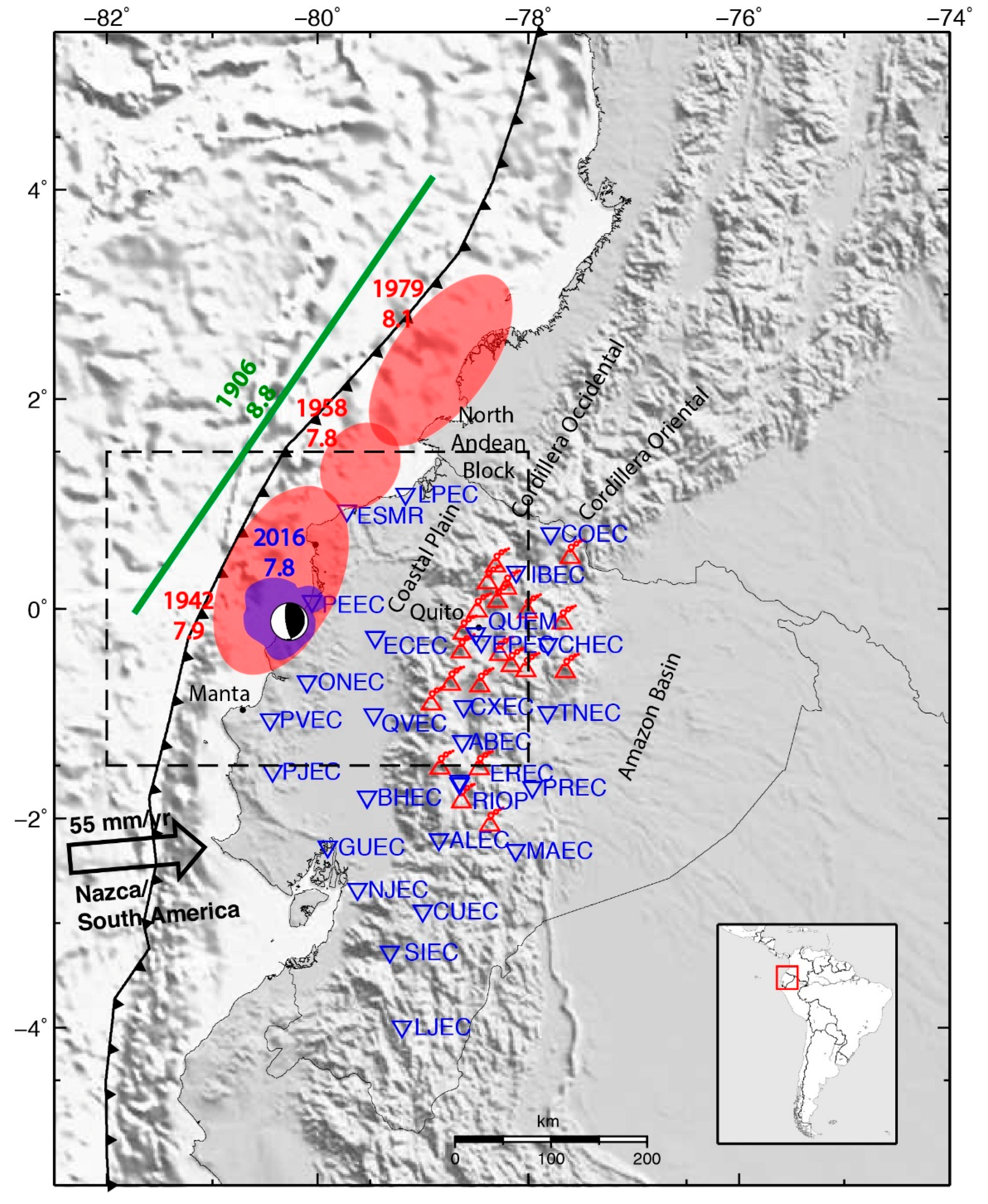
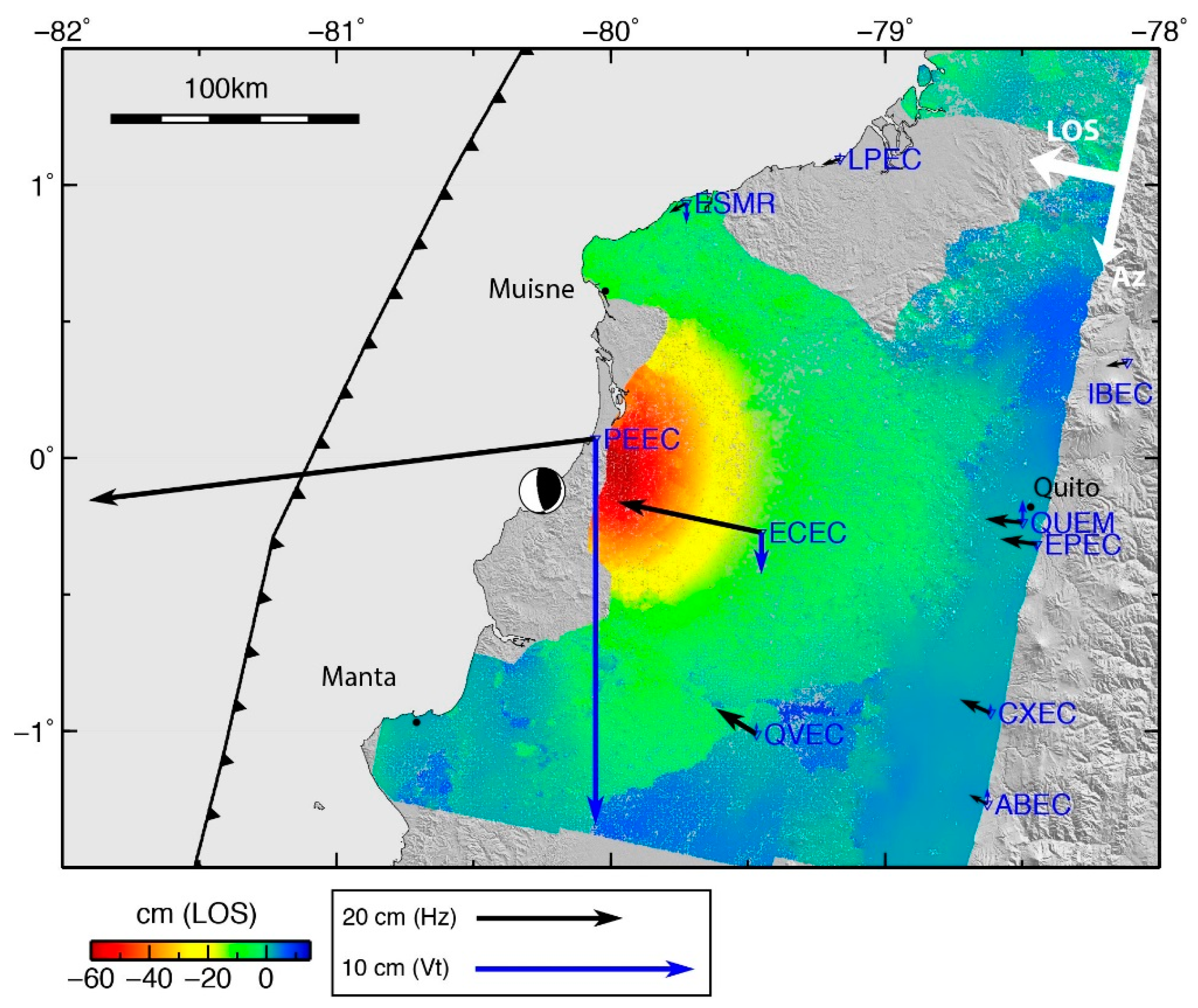
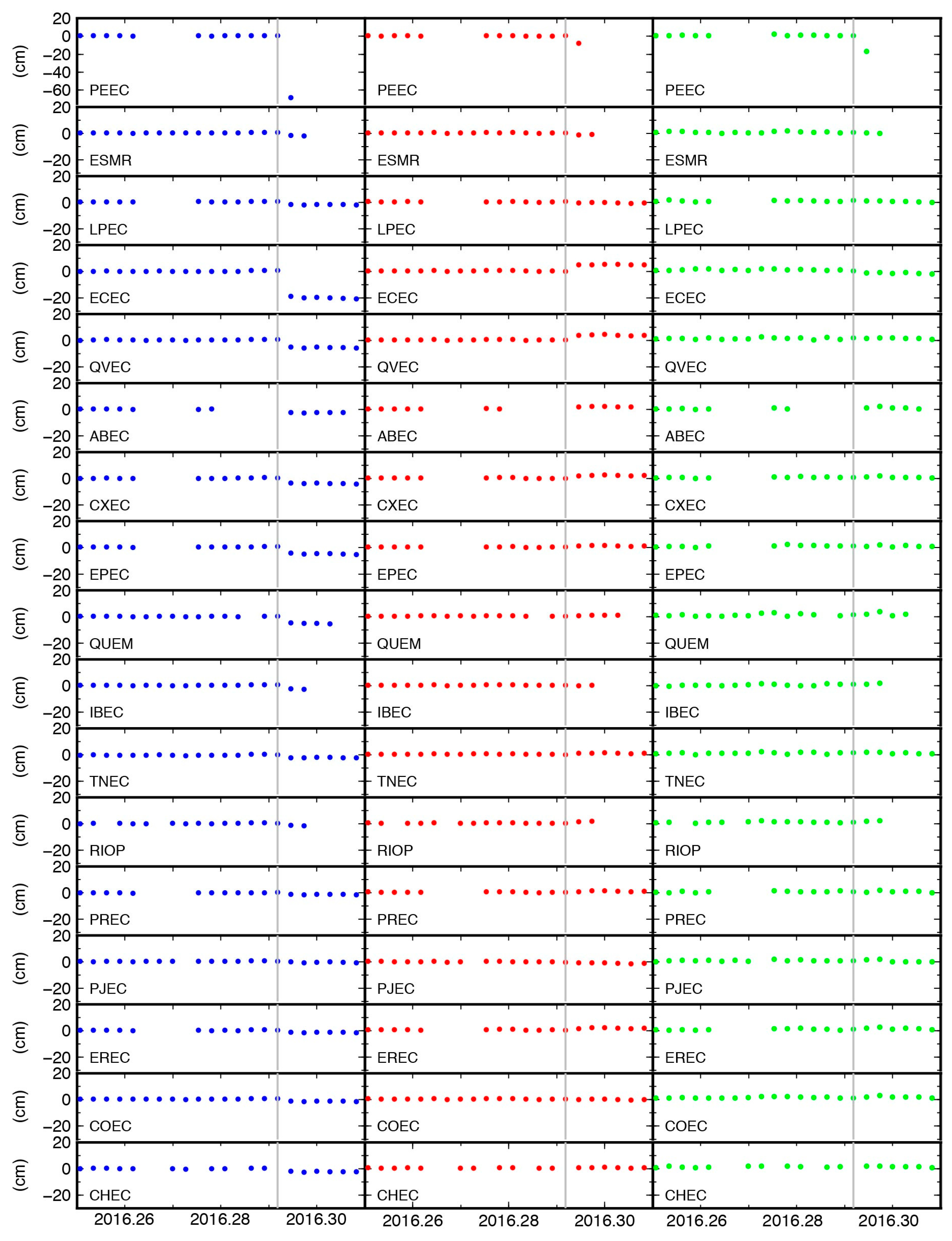
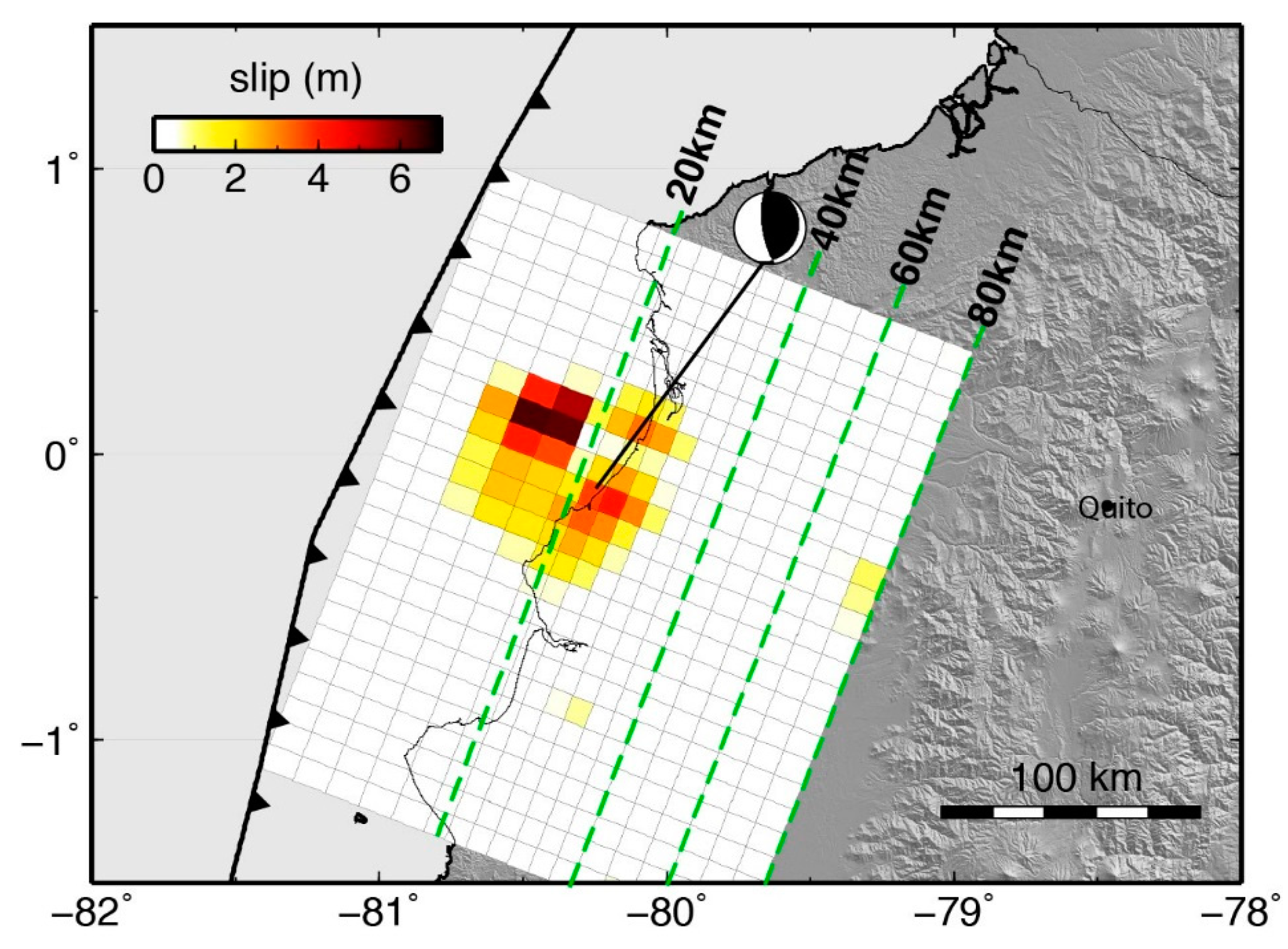
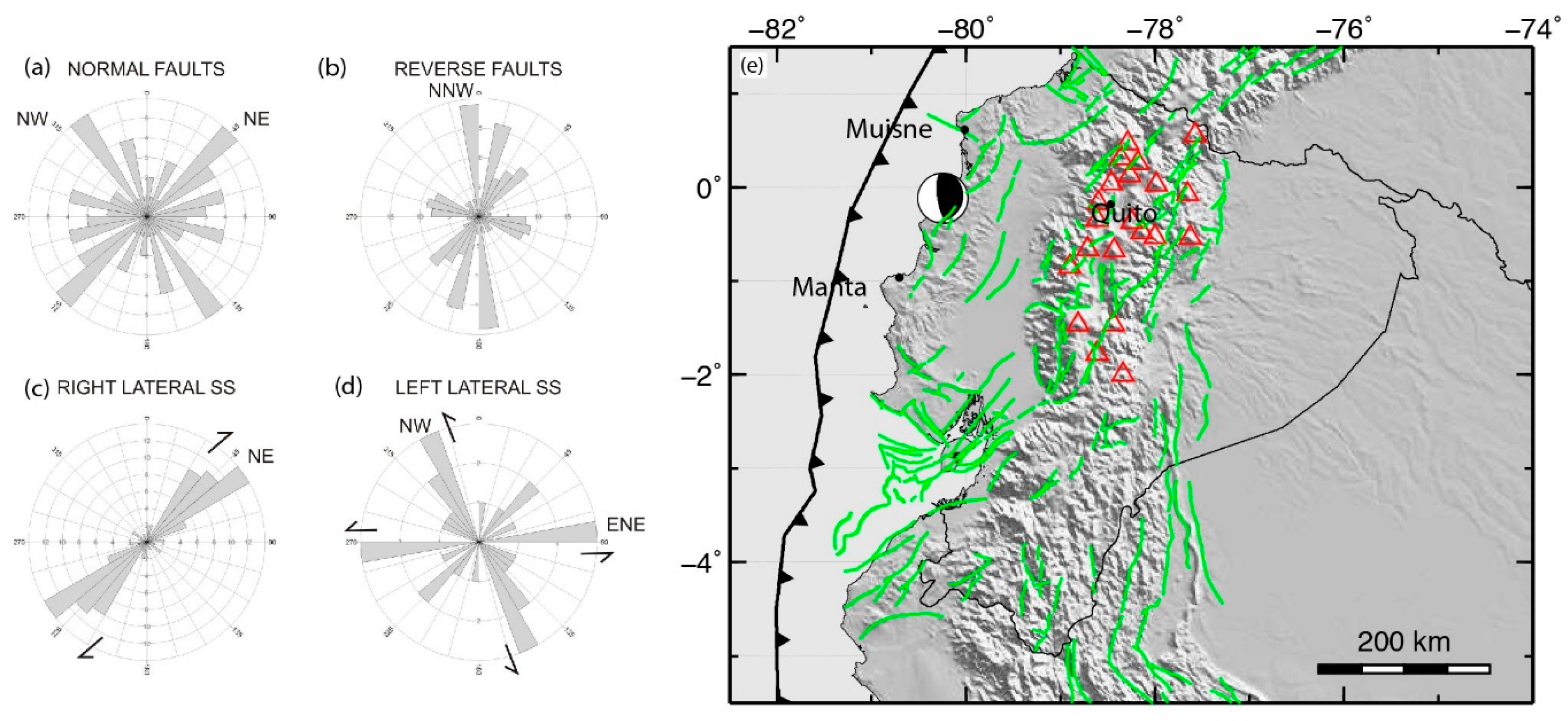
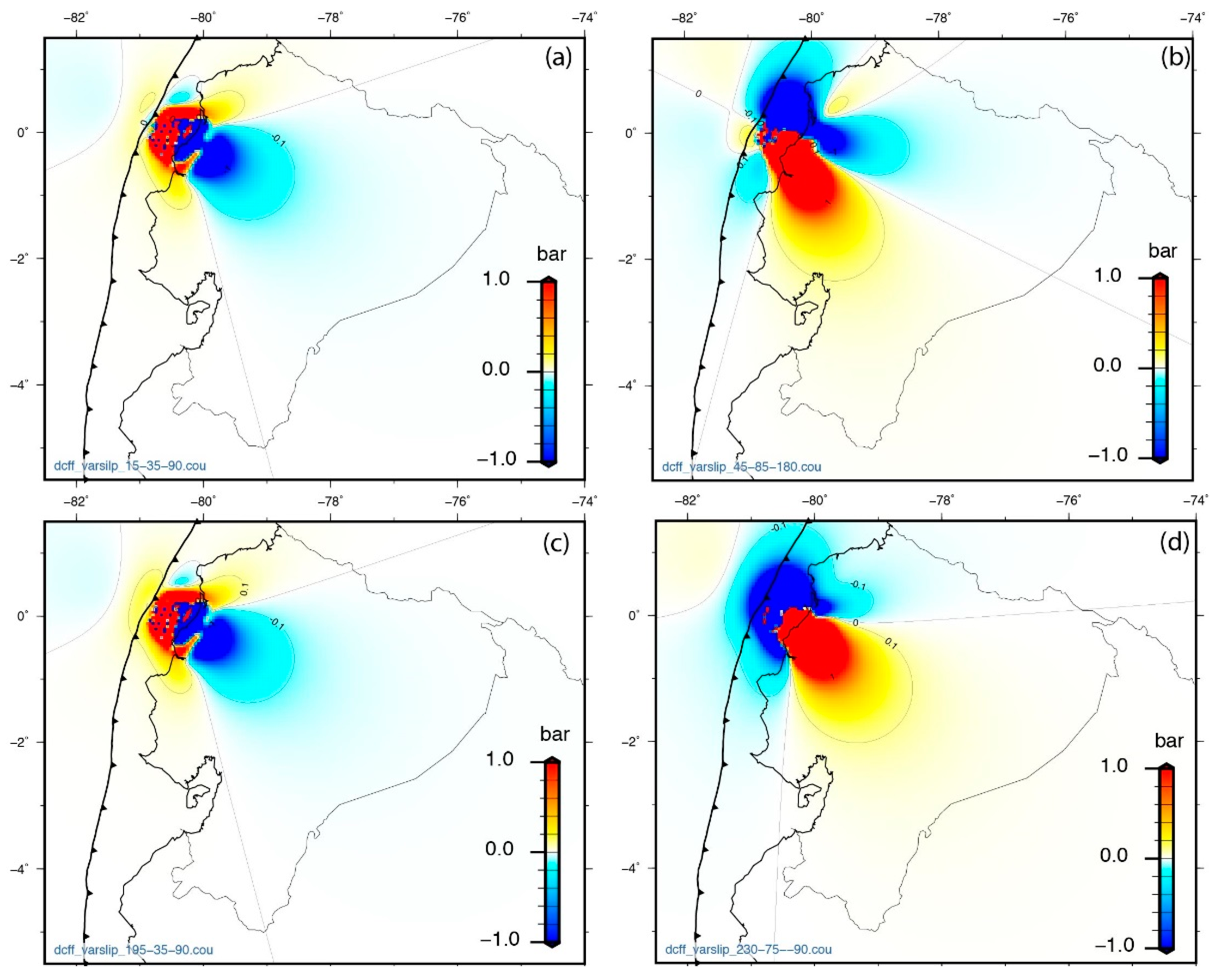
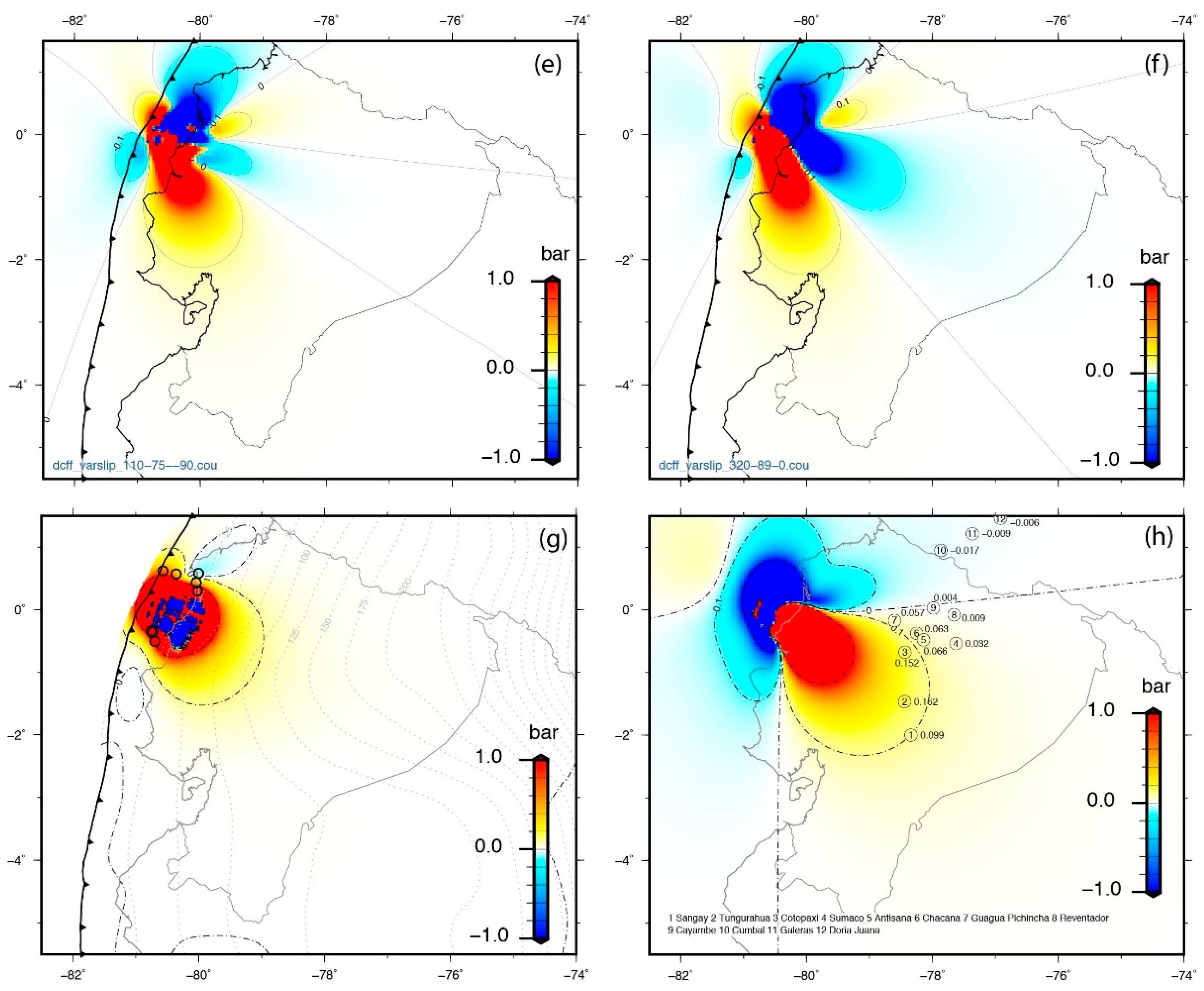
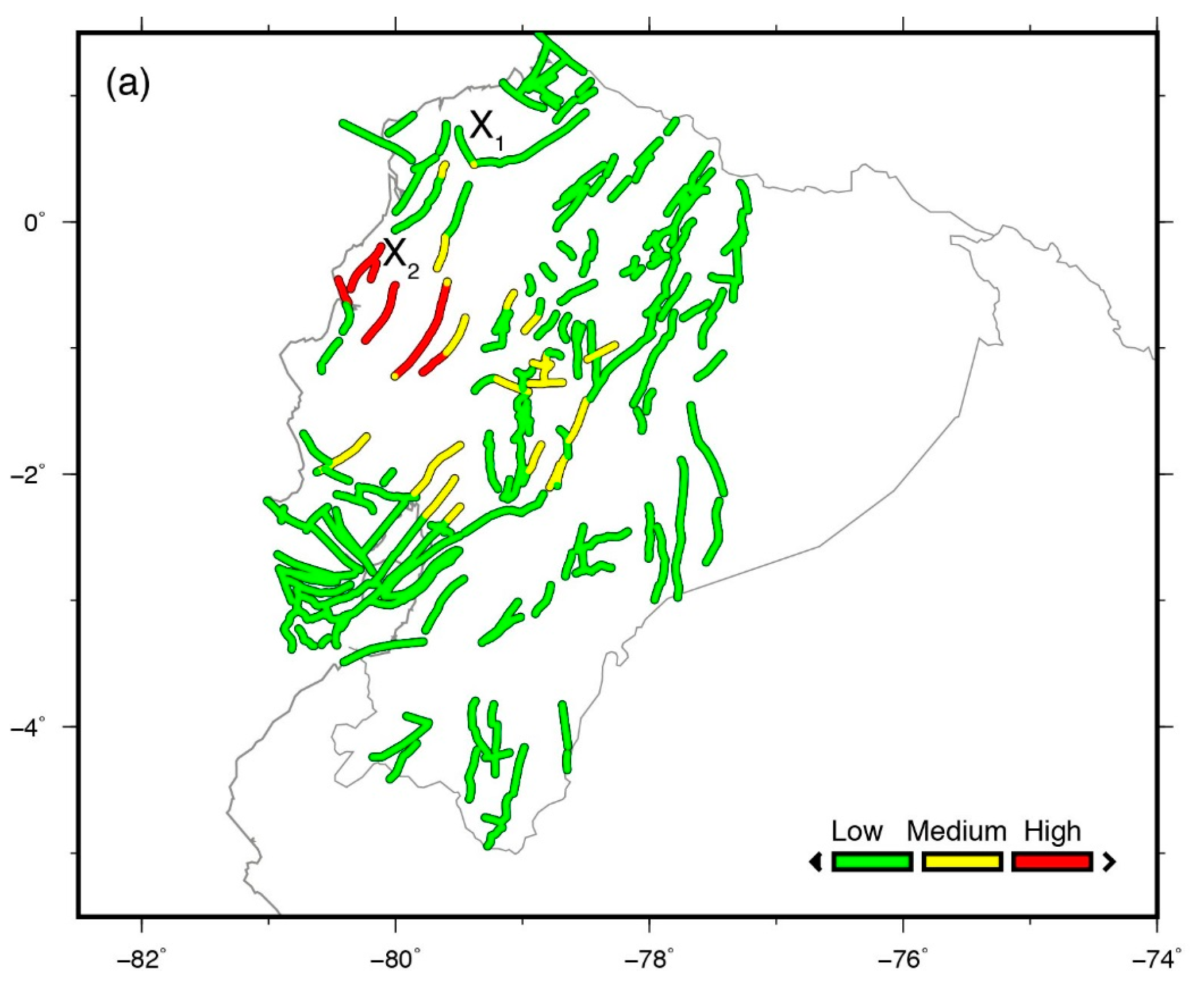
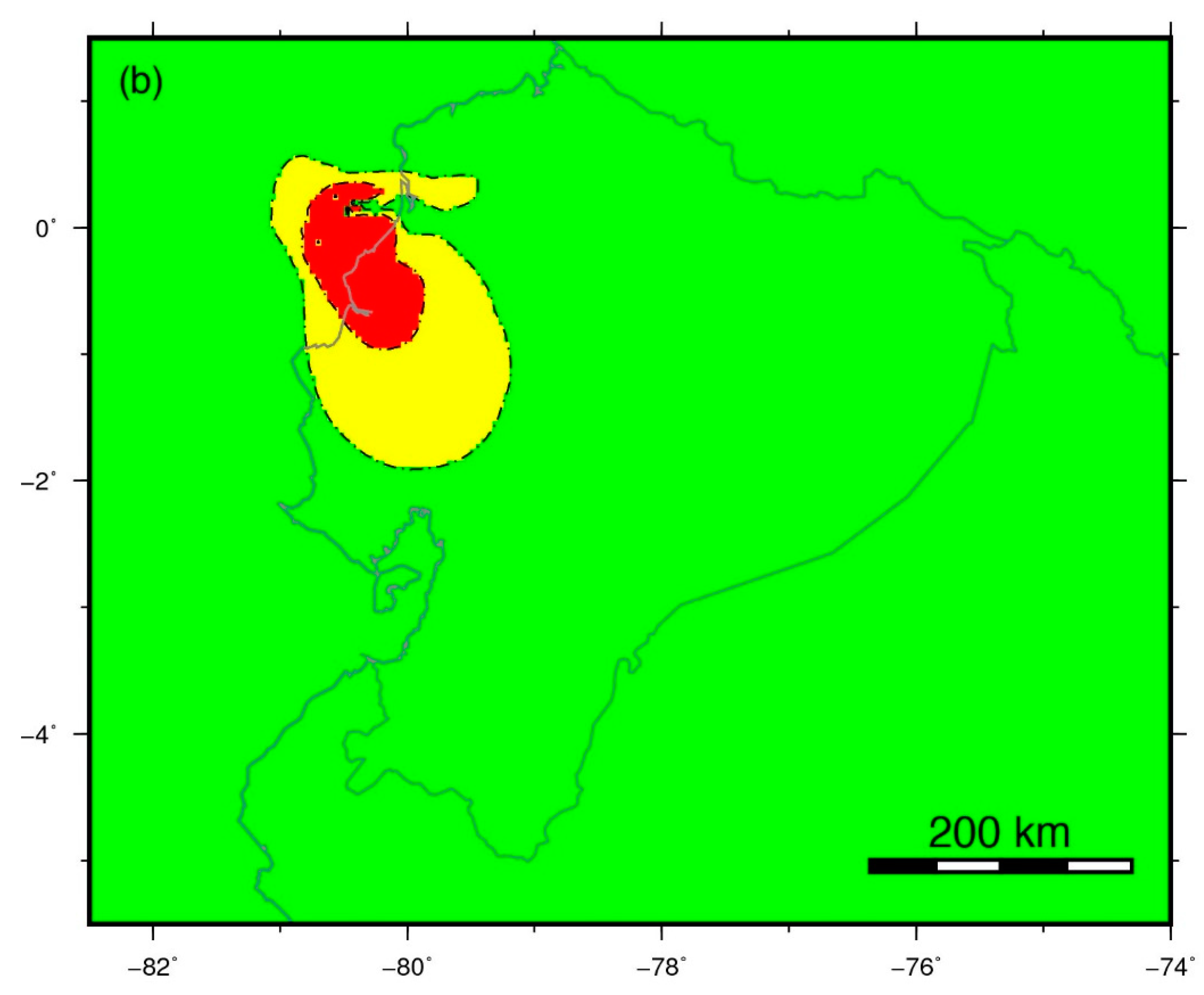
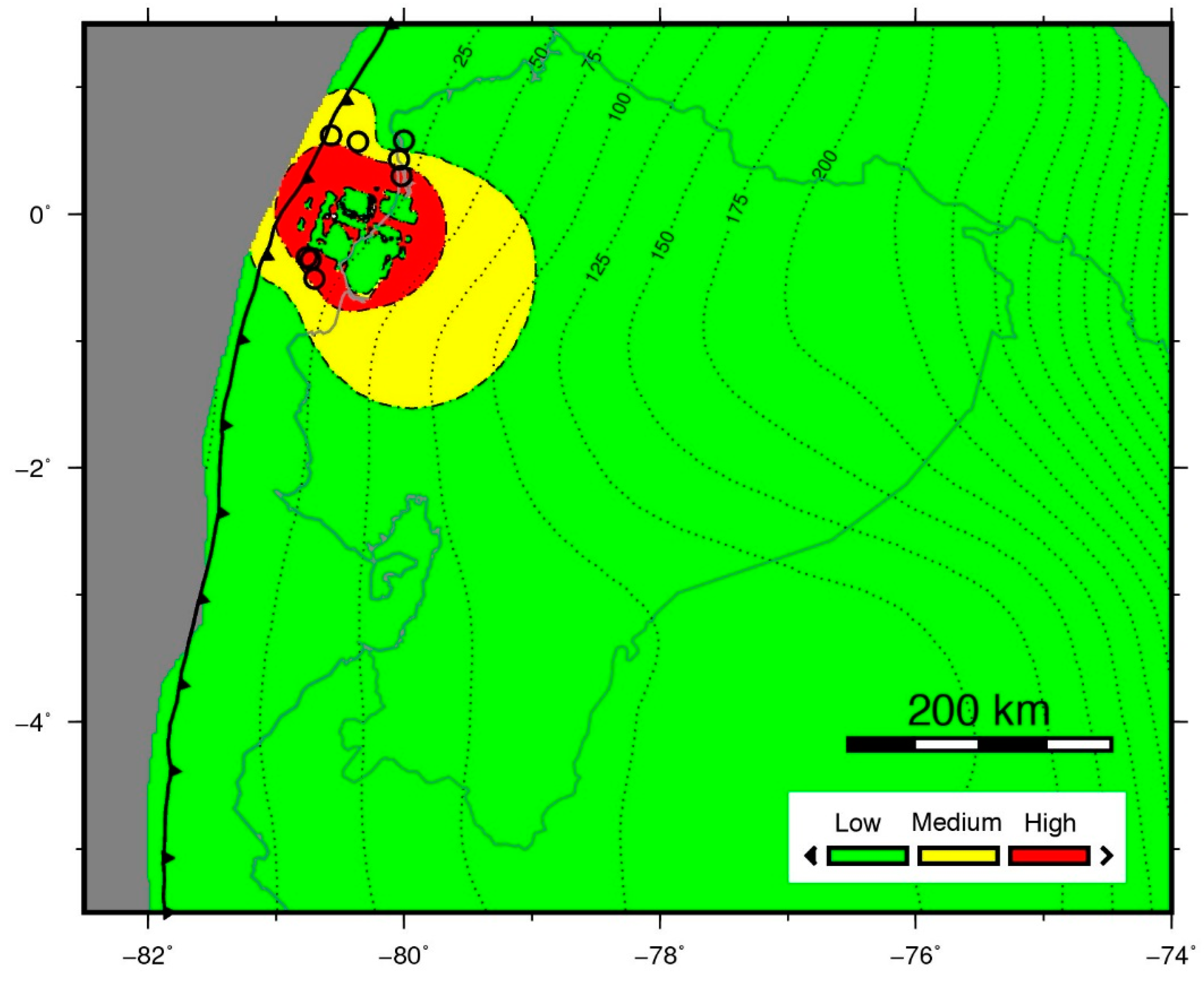
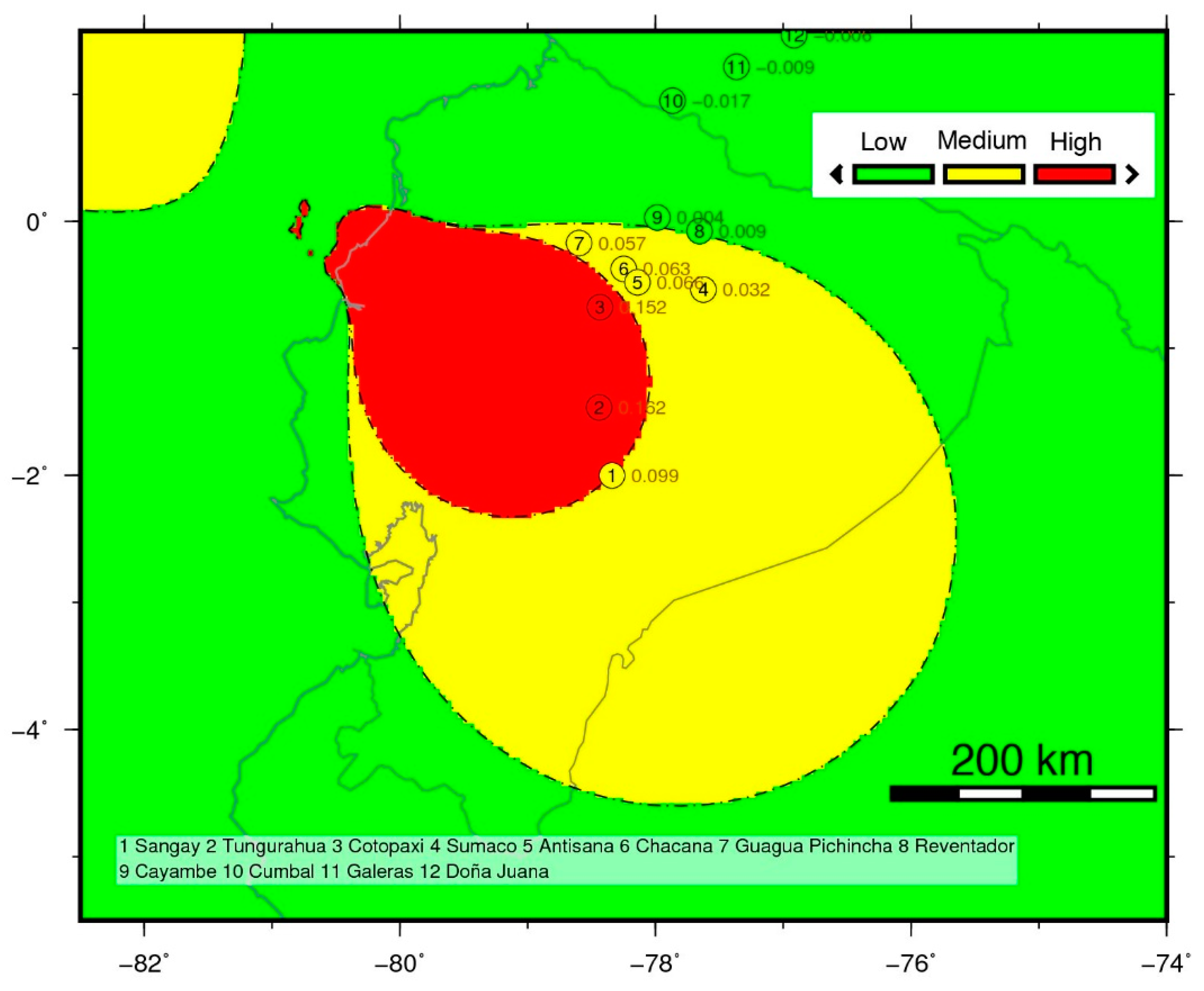
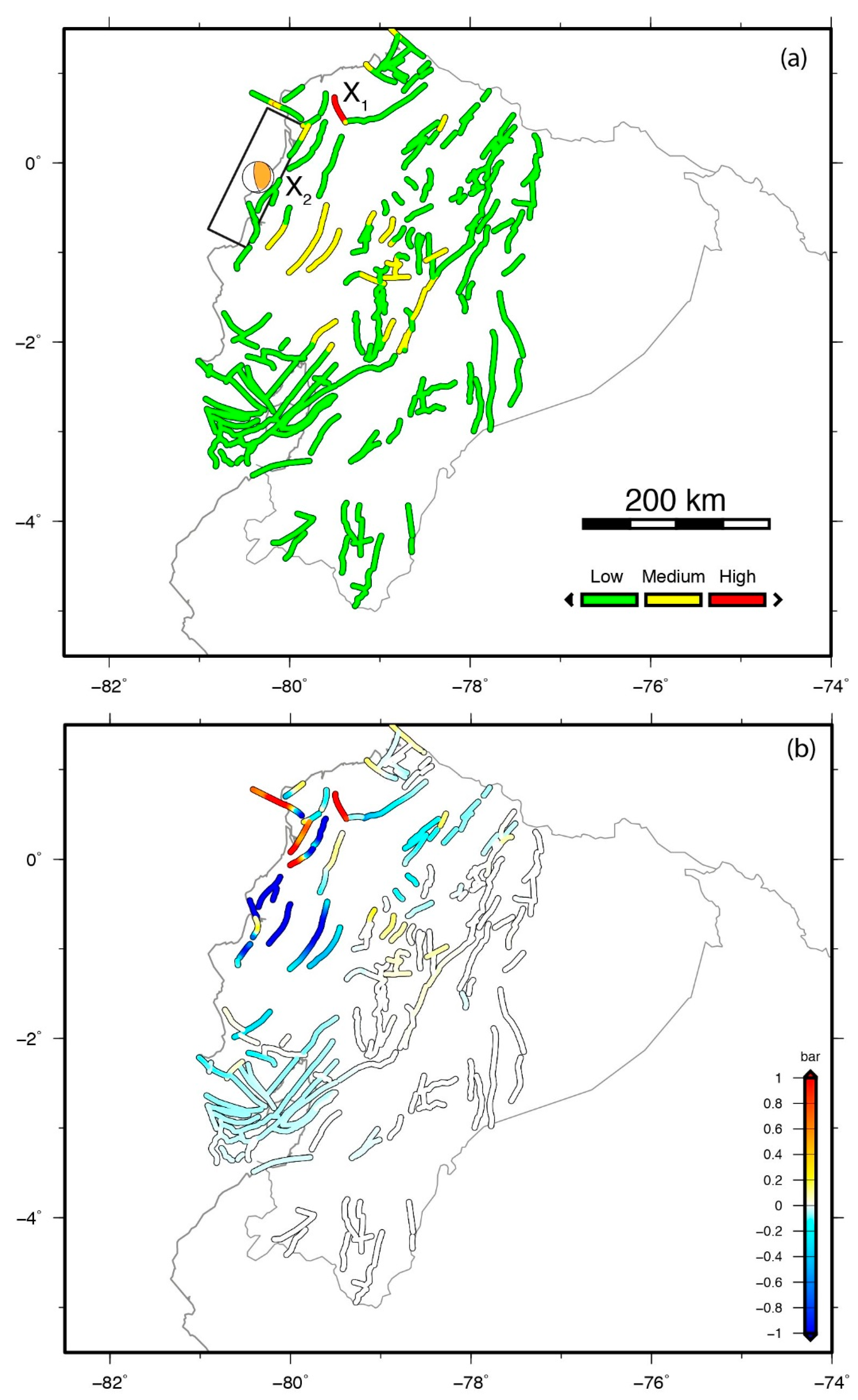
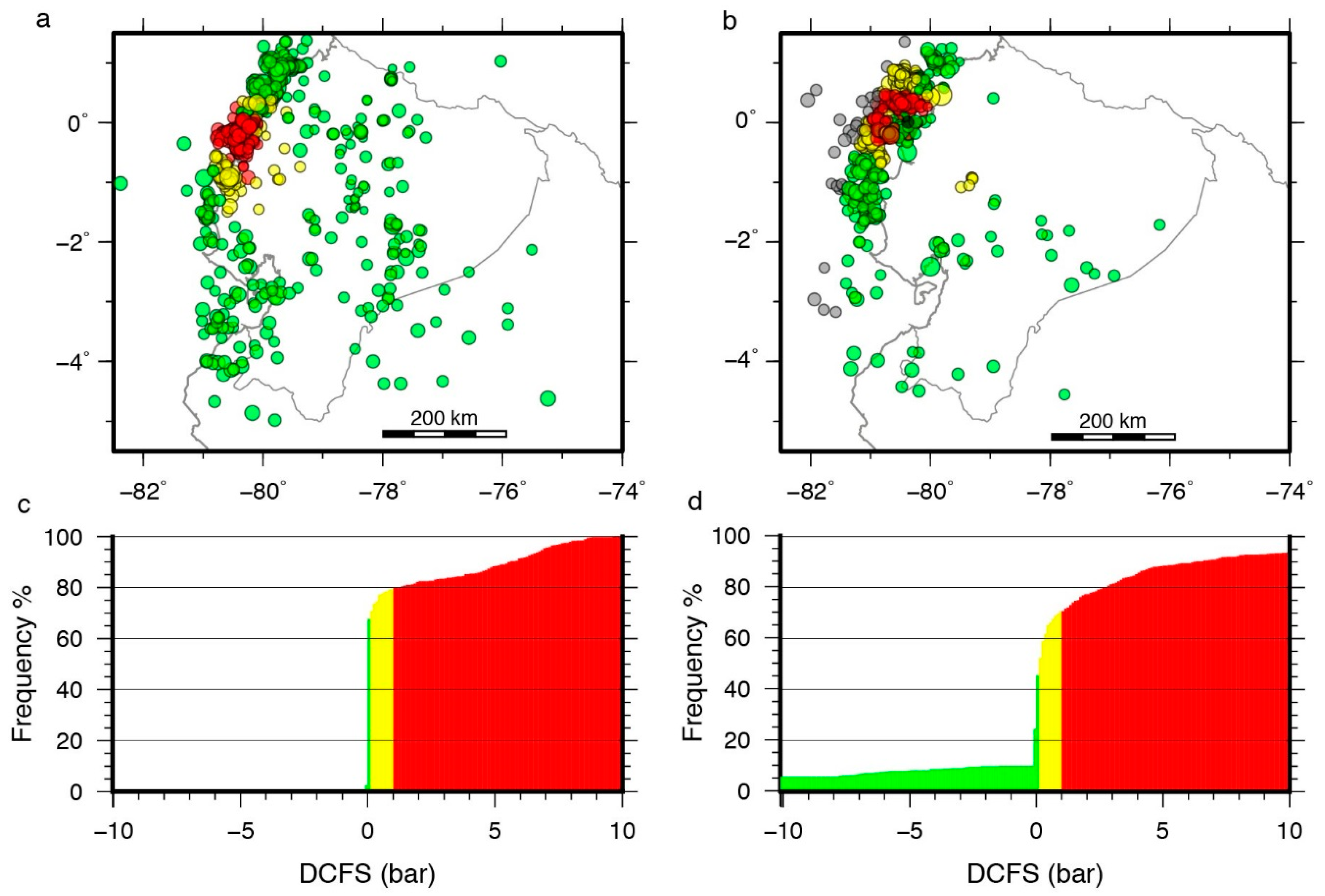
| ID | Location | Displacement (mm) | Error (mm) | |||||
|---|---|---|---|---|---|---|---|---|
| lon | lat | East | North | Up | East | North | Up | |
| ABEC | −78.628 | −1.269 | −24.46 | 12.79 | 7.42 | 0.27 | 0.25 | 0.5 |
| CHEC | −77.814 | −0.339 | −24.14 | 2.89 | 2.59 | 0.26 | 0.21 | 0.61 |
| COEC | −77.787 | 0.716 | −19.60 | −3.00 | 10.31 | 0.24 | 0.19 | 0.5 |
| CXEC | −78.615 | −0.935 | −41.64 | 18.51 | 4.10 | 0.25 | 0.2 | 0.24 |
| ECEC | −79.452 | −0.272 | −197.32 | 41.80 | −18.83 | 0.19 | 0.19 | 0.57 |
| EPEC | −78.446 | −0.315 | −50.16 | 7.21 | −3.30 | 0.27 | 0.21 | 0.41 |
| EREC | −78.651 | −1.671 | −19.07 | 11.32 | 15.85 | 0.21 | 0.17 | 0.61 |
| ESMR | −79.724 | 0.935 | −23.50 | −13.12 | −9.73 | 0.1 | 0.09 | 0.48 |
| IBEC | −78.116 | 0.350 | −29.55 | −4.95 | 2.37 | 0.19 | 0.19 | 0.26 |
| LPEC | −79.164 | 1.095 | −24.60 | −7.96 | 2.99 | 0.25 | 0.33 | 0.41 |
| PEEC | −80.055 | 0.070 | −693.24 | −84.13 | −175.47 | 0.22 | 0.18 | 0.48 |
| PJEC | −80.425 | −1.552 | −9.02 | −7.34 | 7.68 | 0.22 | 0.23 | 0.75 |
| PREC | −77.963 | −1.708 | −10.50 | 5.25 | −8.99 | 0.23 | 0.19 | 0.5 |
| QUEM | −78.497 | −0.237 | −51.44 | 4.93 | 10.40 | 0.4 | 0.46 | 0.47 |
| QVEC | −79.470 | −1.012 | −56.23 | 35.24 | 5.28 | 0.18 | 0.18 | 0.88 |
| RIOP | −78.651 | −1.651 | −18.39 | 11.83 | 10.21 | 0.13 | 0.1 | 0.32 |
| TNEC | −77.816 | −0.990 | −25.82 | 8.80 | 2.09 | 0.15 | 0.23 | 0.32 |
© 2018 by the authors. Licensee MDPI, Basel, Switzerland. This article is an open access article distributed under the terms and conditions of the Creative Commons Attribution (CC BY) license (http://creativecommons.org/licenses/by/4.0/).
Share and Cite
Béjar-Pizarro, M.; Álvarez Gómez, J.A.; Staller, A.; Luna, M.P.; Pérez-López, R.; Monserrat, O.; Chunga, K.; Lima, A.; Galve, J.P.; Martínez Díaz, J.J.; et al. InSAR-Based Mapping to Support Decision-Making after an Earthquake. Remote Sens. 2018, 10, 899. https://doi.org/10.3390/rs10060899
Béjar-Pizarro M, Álvarez Gómez JA, Staller A, Luna MP, Pérez-López R, Monserrat O, Chunga K, Lima A, Galve JP, Martínez Díaz JJ, et al. InSAR-Based Mapping to Support Decision-Making after an Earthquake. Remote Sensing. 2018; 10(6):899. https://doi.org/10.3390/rs10060899
Chicago/Turabian StyleBéjar-Pizarro, Marta, José A. Álvarez Gómez, Alejandra Staller, Marco P. Luna, Raúl Pérez-López, Oriol Monserrat, Kervin Chunga, Aracely Lima, Jorge Pedro Galve, José J. Martínez Díaz, and et al. 2018. "InSAR-Based Mapping to Support Decision-Making after an Earthquake" Remote Sensing 10, no. 6: 899. https://doi.org/10.3390/rs10060899
APA StyleBéjar-Pizarro, M., Álvarez Gómez, J. A., Staller, A., Luna, M. P., Pérez-López, R., Monserrat, O., Chunga, K., Lima, A., Galve, J. P., Martínez Díaz, J. J., Mateos, R. M., & Herrera, G. (2018). InSAR-Based Mapping to Support Decision-Making after an Earthquake. Remote Sensing, 10(6), 899. https://doi.org/10.3390/rs10060899










